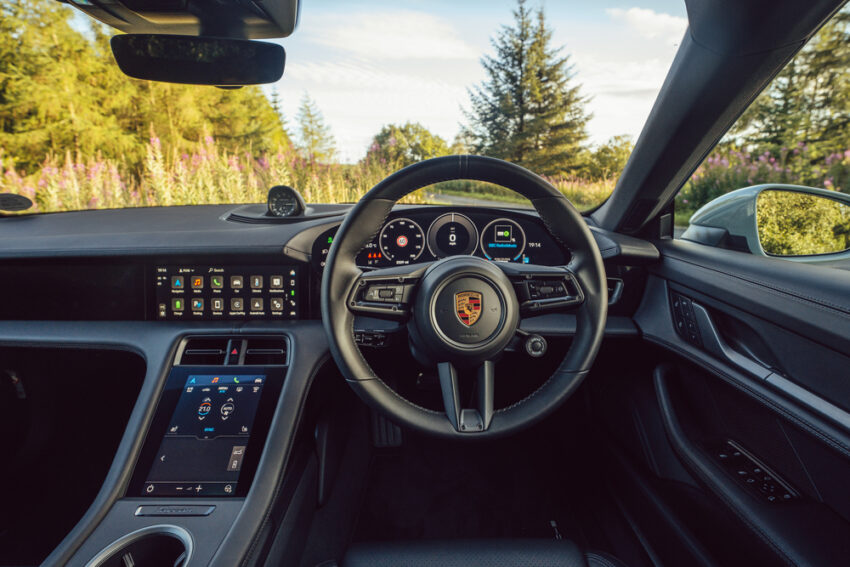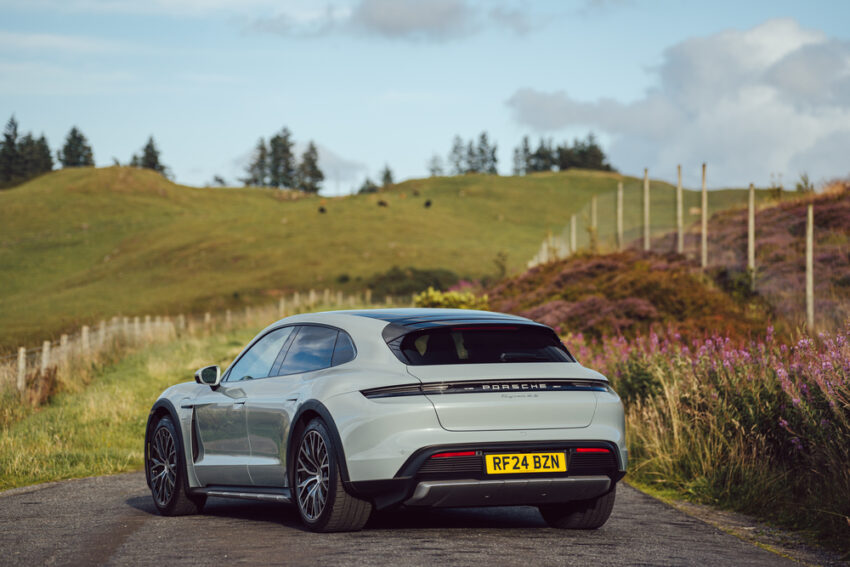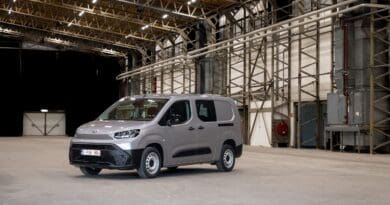2024 Porsche Taycan review: Has the best just got better?
Does a midlife update to the Taycan deliver the major changes promised?
The Porsche Taycan has been a stand-out model in the EV world in recent years.
It has managed to blend Porsche’s trademark driver engagement with an electric drivetrain that offers impressive performance, range and rapid charging. Frankly, even with more and more rivals coming to market, it was still one of the best all-rounders out there.
But Porsche isn’t a company to rest on its laurels, so 2024 brings a mid-cycle update for the Taycan, promising major technical changes beneath the lightest of visual upgrades.
Design, interior and technology
It’s no great surprise that this refresh hasn’t resulted in major changes to how the Taycan looks. It was already an incredibly striking and recognisable car, so why mess with that?
As a result, the visual changes are the sort of thing you’d only notice if you parked a new model directly next to an old one. The headlights are new, flatter and even more high-tech than before. With 32,000 controllable LED elements, they can adapt to oncoming traffic, roadworks and motorway driving to provide maximum illumination without bothering other drivers. They also now display the Taycan’s trademark four-point motif at night as well as during the day.
To accommodate the flatter lights, the wings have also been resculpted. It’s a similar story at the rear, where the lights have been tinkered with and the full-width light bar now features an illuminated Porsche crest.
As before, the Cross Turismo I was testing features some light body cladding and a slightly raised ride height for a more rugged look and, allegedly, some off-road ability. My car also featured the new Active Ride suspension which, among its tricks, automatically raises the car’s ride height when you open the door to make access easier. Like a Range Rover in reverse.

Inside, most of the hardware is the same, with the focus on making the car’s user interface even more packed but easier to use. As before, the driver gets a 16.8-inch digital instrument display and there’s a responsive and crisp 10.9-inch central touchscreen with an 8.4-inch climate control touch panel beneath. There’s also the (£1,000) option of another 10.9-inch touchscreen directly in front of the passenger, which gives access to most of the same functions as the main screen a mere inch or two to the right, but also allows passengers to watch videos on the move.
Elsewhere the Taycan has been left alone, so it remains effortlessly cool, comfortable and practical. There’s loads of space for four adults to get comfortable but the central hump means that the middle rear seat won’t get much use even in 4+1-seat configurations. The estate body also provides decent headroom – certainly better than the fastback version – and while the boot is a relatively small 446 litres, it’s easily accessible and a practical shape. It’s also complemented by an 84-litre ‘frunk’.
Battery, motor and performance
While there haven’t been too many big changes on the surface, Porsche has made some major alterations under the skin of the Taycan to give it more power, more range, faster charging and better handling.
All versions have been given a new rear motor that offers up to 107bhp more, depending on the model. That means entry-level Taycans now offer 402bhp, while the bonkers Turbo GT packs up to 1,093bhp.
Somewhere in the middle sits our 4S Cross Turismo, whose regular output has been upped from a healthy 483bhp to 510bhp. Overboost now provides a brief maximum of 590bhp – enough to get from 0-62mph in 3.6 seconds and leave you feeling like a hippo has just sat on your chest when you engage launch control.
It’s not as if the Taycan was slow before but it’s now around half a second faster to 62mph in every variant, offering exactly the sort of performance you’d expect from the badge. Throttle response is instant at any speed but carefully measured. Like the brakes and steering there’s a beautiful linearity and, as a whole, they give you complete confidence in how the car will behave.
On twisting country roads it is direct, accurate and nimble, disguising its size well and darting with enthusiasm between corners thanks partly to impressive levels of grip and partly to the optional four-wheel steering.

All cars get adaptive air suspension as standard that brilliantly balances control with comfort, absorbing bumps while keeping the body commendably flat. Aiding that is the optional Active Ride, which is intended to minimise pitch and roll using clever hydraulics in place of regular anti-roll bars. It activates in normal and ‘range’ modes to offer the smoothest drive, while automatically deactivating in Sport and Sport+ models so you can more clearly feel what the car is doing and how it’s responding to your inputs.
It’s a clever system that, in theory, offers the best of both worlds. Certainly during sporty driving the car feels as sharp and poised as ever. It’s when you take it easy that I’m less convinced. For me, it isolates the cabin from the road too much and you feel almost as if you’re floating above the road rather than sitting on it. That’s fine in a Rolls-Royce but feels odd in the Taycan.
Performance Battery Plus models, such as the car I tested, have also had a major battery upgrade, with the usable capacity increasing from 83.7kWh to 97kWh. At the same time huge amounts of work have gone into making the Taycan more efficient. That new rear motor is less energy-hungry, the car is lighter than before and the battery management and cooling have been improved, as have the heat pump performance and the energy recuperation.
All-in-all it means the Taycan’s range has increased by up to 35%. The most efficient variant now manages up to 421 miles on a charge and the 4S Cross Turismo here does up to 360, compared to 296 previously. Five years ago that would have seemed almost impossible.
What’s more, Porsche has also improved the charging. The Taycan was already one of the fastest charging EVs on the market – at 270kW – but that’s now been increased to 320kW. It has also improved the battery management to allow it to charge faster for longer, even without preconditioning. So despite the larger capacity, charging times have been cut – even with the battery at a low 15 degree, the 10-80% charging time has dropped from 37 minutes to 18 minutes.
Price and specification
All those improvements must come at a price and that’s reflected in a £6,000 hike in the starting price of the 4S Cross Turismo.
The Taycan range now starts at £86,500 for the RWD saloon, rising to £186,300 for the Turbo GT. The 4S Cross Turismo sits towards the lower end of the range starting at £100,400.
To that, our car added an astonishing £30,000 of options, from £6,291 for the Active Ride package to £1,000 for a Bose sound system and £389 for tinted rear glass.
You are paying for all the brilliant technology that lets the car go from standstill to 62 in the blink of an eye, handle magnificently, and charge faster than pretty much anything else on the road. I’ll even accept that perhaps the clever suspension is worth £6,000 extra. But asking more than £1,000 for adaptive cruise control when it’s standard on a £30,000 Volkswagen seems like taking liberties.
Verdict
Price aside, the latest Taycan is a great example of a midlife refresh done right. The design and comfort needed very little change and instead Porsche has focused on making a great drivers’ car even better.
While the extra power, pace and chassis improvements are welcome, it’s the advances in battery size and management that will make even more of a difference to owners and make this brilliant all-rounder even better than before.

Porsche Taycan 4S Cross Turismo
- Price: £100,400 (£130,406 as tested)
- Powertrain: two-motor, all-wheel-drive
- Battery: 97kWh
- Power: 510bhp (590bhp with overboost)
- Torque: 513lb ft
- Top speed: 149mph
- 0-62mph: 3.6 seconds
- Range: 360 miles
- Consumption: 3.14m/kWh
- Charging: up to 320kW






